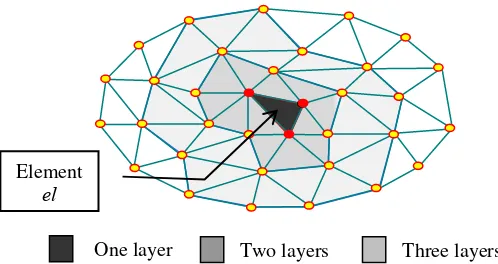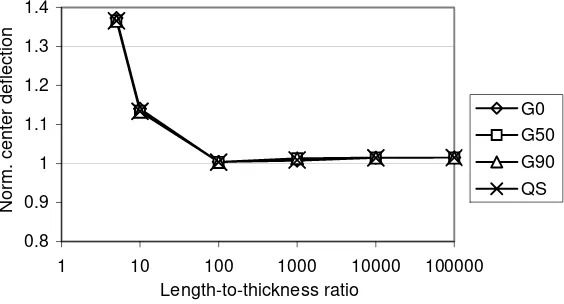The Tenth East Asia-Pacific Conference on Structural Engineering and Construction August 3-5, 2006, Bangkok, Thailand
KRIGING-BASED FINITE ELEMENT METHOD FOR ANALYSES OF
REISSNER-MINDLIN PLATES
WONG Foek Tjong1 and Worsak KANOK-NUKULCHAI2
ABSTRACT: A class of finite element method using kriging shape functions is developed to analyze Reissner-Mindlin plates. The shape functions are constructed using kriging interpolation (KI) over a set of nodes encompassing a number of layers of elements. In addition to the commonly used gaussian correlation function, a quartic spline function is introduced as the correlation function in the KI. The appropriate ranges of the kriging correletion parameters, both for the gaussian and quartic spline correlation functions, are determined based on the lower and upper bounds proposed by Plengkhom and Kanok-Nukulchai. The discretized equations are formulated using the standard displacement-based finite element procedure on the variational form. The problem domain is discretized using triangular elements. A study on a simply supported square plate is carried out to investigate the shear-locking phenomenon. The study shows that the use of high order basis can alleviate shear shear-locking and the locking disappears if bi-cubic basis is used. When there is no shear locking, the results are insensitive to the change of the type of correlation function.
KEYWORDS: Reissner-Mindlin plate, finite element, kriging, triangular element, shear locking
1 INTRODUCTION
An enhancement of the finite element method using kriging shape functions (K-FEM) was recently proposed [1] as a convenient implementation of the element-free Galerkin method with moving KI [2]. In the classical FEM, the shape function associated with a node is a hat function tied to the element structure. Its influence extends over one layer of elements around the node. In this new class of FEM, shape functions are constructed using KI over a set of nodes encompassing a number of layers of elements. Thus, the shape function associated with a node extends beyond one layer of elements. With K-FEM, very smooth field variables and their derivatives can be obtained without any smoothing process. Any requirement for high order shape functions can easily be fulfilled without any change of the element. The advantage of this method over mesh-free methods is that it inherits the computational procedure of FEM so that the modification from a standard FE program to a K-FEM program is straightforward.
The K-FEM has been successfully applied to solve 1-D bar and 2-D plane stress/plane strain problems [1]. In this study, the K-FEM is developed for analyses of plates based on Reissner-Mindlin theory. In addition to the commonly used gaussian correlation function, a new type of correlation function for KI is proposed. The range of correlation parameter suggested by Plengkhom and Kanok-Nukulchai [1] is employed to obtain the formulae relating the parameter bounds with the number of influence nodes. The discretized equations are formulated using the standard displacement-based FE procedure on the variational form. The same kriging shape functions are used for the deflection and rotation
1
Lecturer of Petra Christian University, Indonesia
2
fields. Triangular elements are chosen as the integration cells owing to its flexibility in representing complex geometry and its easiness to be automatically generated. A numerical experiment on a simply supported square plate is carried out to investigate the shear-locking phenomenon. The effects of choosing different order of basis functions and different type of correlation functions are investigated.
2 KRIGING INTERPOLATION
Named after Danie G. Krige, a South African mining engineer, kriging is a well-known geostatistical technique for spatial data interpolation in geology and mining [2-4]. Using this interpolation, every unknown value at a point can be interpolated from known values at scattered points in its specified neighborhood. This section presents a summary of KI formulation in the context of K-FEM. A detail explanation and derivation of kriging can be found in the geostatistics literatures (e.g. [4] and [5]).
For each element, the KI is defined over a set of nodes in a sub-domain Ω ⊆ Ωel encompassing a predetermined number of layers of elements (see Figure 1). The KI function over sub-domain Ωel can be expressed in the usual FE form as
h( ) ( )
u x =N x d (1)
where N(x) is the 1×n matrix of shape functions and d is the n×1 matrix of field values at the nodes. In contrast to FE, here n in not the number of nodes in the element, but it is the number of all nodes in the domain of interpolation (DOI) of element el.
Figure 1. Domain of interpolation for element el with one, two and three layers of elements
The shape function matrix is obtained from
T T
( )= ( ) + ( )
N x p x A r x B (2)
In this equation,
[
]
T
1
( )= p( ) ... pm( )
p x x x (3)
is vector of m-term-polynomial basis and
[
]
T1
( )= C h( ) ... C h( )n
r x (4)
is vector of covariance between random function U at nodes i=1,…,n and U at the point x. Note that in kriging formulation, a deterministic function u(x) is viewed as a realization of a random function U(x). The covariance between a pair of random variables U(x) and U(xj) depends only on the distance between x and xi, i.e. hi = −x xi . Thus, cov[ ( ), ( )]U x U xi =C h( )i . Matrices Am n× and Bn n× are
defined as follows:
One layer Two layers Three layers
Element
T 1 1 T 1
Setting up the kriging shape functions, Equation (2), requires a model of covariance function, C(h). This covariance model is more conveniently expressed in term of coefficient of correlation function or, shortly, correlation function. The coefficient of correlation function between a pair of random variables U(x) and U(x+h) is ρ( )h =C h( ) σ2, where 2
[
]
[
]
var U( ) var U( )
σ = x = x h+ . According to Gu [2], σ2 has no influence on the final results and so in this study it is taken as 1. One of the widely used correlation model is the gaussian correlation function, that is,
2 ( )h exp( ( h d/ ) )
ρ = −θ (7)
where θ>0 is the correlation parameter, h is the distance between two points, and d is a scale factor to normalize the distance. In this study, d is taken to be maximum distance between a pair of nodes in the DOI. Besides the gaussian, a new correlation function is introduced, that is,
2 3 4
This function is quartic spline (QS), adopted from the commonly used weight function in the moving least-squares approximation (see e.g. [6]).
The quality of the kriging is influenced by the parameter θ. Plengkhom and Kanok-Nukulchai [1] proposed the lower and upper bound criteria for θ to guarantee the quality of KI. The lower bound is given by
where a is the order of basis function, while the upper bound is given by
det( ) 1 10R ≤ × −b (10)
where b is the dimension of problem. For two-dimensional problem with quadratic basis function, for example, a=2 and b=2.
3 NUMERICAL INVESTIGATION ON THE UPPER AND LOWER BOUNDS
correlation parameters are displayed in Figure 3(a) and Figure 3(b) together with their quadratic regression curves.
Figure 2. (a) Sample elements in the square (b) Various layered DOI for the element in the center
Figure 3. The lower and upper bounds of (a) gaussian and (b) QS correlation parameters for various number of nodes
Based on the above and other numerical investigations on the same square domain but with some irregularly distributed nodes, the authors propose the parameter functions for implementation in the K-FEM as follows:
For gaussian correlation parameter, the lower-bound function is
low 2
while the upper-bound function is
up 2
0.34 0.7 for 3 10 -2.484E-3 +0.3275 0.2771 for 10 55
0.05426 7.237 for 55
The gaussian parameter function is
low (1 ) up
f f
θ = θ + − θ , 0≤ ≤f 1 (13)
where f is a scale factor.
For QS correlation parameter, the proposed function is
0.1329 0.3290 for 3 10 1 for 10
n n
n
θ = ⎨⎧ − ≤ <
≥
⎩ (14)
Based on the authors’ experience, although Equations (11)-(14) are developed based on a limited number of samples in the square domain, they are applicable for any shape of 2D domain.
4 NUMERICAL RESULTS FOR A SIMPLY SUPPORTED SQUARE PLATE
An important issue in the numerical analysis of Reissner-Mindlin plates is the shear locking. To observe the locking behaviour in the kriging-based finite element analyses (K-FEA), a simply-supported square plate under uniform load is analysed. Due to symmetry, only a quarter of the square plate is considered. The quarter of the plate is discretized by uniform nodal distribution of 8 8× and triangular elements are generated automatically using Delaunay algorithm.
Effect Of Basis Order
To observe the effect of choosing different basis orders, the following options are used in the analyses:
• gaussian correlation function with mid-value parameters (f=0.5),
• quadratic (P2), bi-quadratic (PB2), cubic (P3), quartic (P4), and bi-cubic (PB3) basis functions,
• four influence-layers for quadratic, bi-quadratic, and cubic basis functions, and
• four influence-layers and minimum 21 nodes for quartic and bi-cubic basis functions.
The minimum 21 nodes for quartic and bi-cubic basis functions is needed to maintain good condition of matrix R in Equation (6), when constructing the kriging shape functions for each element.
The center deflections from K-FEA, normalized with respect to the corresponding thin-plate-theory solutions [7], are plotted in Figure 4. It can be seen from the figure that in general, the shear locking relieves as the order of the basis function increases. The locking disappears if bi-cubic basis is used. This phenomenon is similar to the results of Garcia et al. [8] in the hp-clouds method, of Liu [9, pp.468-469] and Noguchi et al. [6] in the element-free Galerkin method, and of Liu [9, pp.484-486] in the radial point interpolation method.
Effect Of The Type Of Correlation Function
Employing the best option of the basis functions, PB3, the plate is analysed using different correlation functions: gaussian with f=0 (G0), gaussian with f=50 (G50), gaussian with f=90 (G90), and QS. The other analysis options are the same as in the previous investigation.
The normalized center deflections are plotted against the length-to-thickness ratios in Figure 5. The figure shows that the results are practically insensitive to the change of the correlation function or correlation parameter.
5 CONCLUSIONS
0 0.2 0.4 0.6 0.8 1 1.2 1.4
1 10 100 1000 10000 100000 Length-to-thickness ratio
Norm. center deflection
P2 PB2 P3 P4 PB3
Figure 4. Normalized center deflection vs thickness aspect ratio (log scale) for various basis order
0.8 0.9 1 1.1 1.2 1.3 1.4
1 10 100 1000 10000 100000 Length-to-thickness ratio
Norm. center deflection
G0 G50 G90 QS
Figure 5: Normalized center deflection vs thickness aspect ratio (log scale) for various types of correlation functions
6 REFERENCES
1. Plengkhom, K. and Kanok-Nukulchai, W., “An Enhancement of Finite Element Methods with Moving Kriging Shape Functions”. International Journal of Computational Methods, Vol. 2, 2005, pp. 451-475.
2. Gu, L., “Moving Kriging Interpolation and Element-Free Galerkin Method”. Int. J. Numer. Meth. Engng, Vol. 56, 2003, pp. 1-11.
3. Tongsuk, P. and Kanok-Nukulchai, W., “Further Investigation of Element-Free Galerkin Method Using Moving Kriging Interpolation”. International Journal of Computational Methods, Vol. 1, 2004, pp. 345-365.
4. Olea, R.A., Geostatistics for Engineers and Earth Scientists. Boston, Kluwer Academic Publishers, 1999.
5. Wackernagel, H., Multivariate Geostatistics. Second Edition, Springer, 1998.
6. Noguchi, H., Kawashima, T. and Miyamura, T., “Element free analyses of shell and spatial structures”. Int. J. Numer. Meth. Engng, Vol. 47, 2000, pp. 1215-1240.
7. Timoshenko, S. and Woinowsky-Krieger, S., Theory of Plates and Shells. Second Edition, McGraw-Hill, 1959.
8. Garcia, O., Fancello, E.A., Barcellos, C.S. and Duarte, C.A., “hp-Clouds in Mindlin’s thick plate model”. Int. J. Numer. Meth. Engng, Vol. 47, 2000, pp. 1381-1400.


